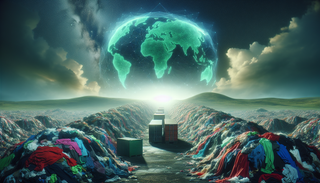
The Surge of Disposable Style
The average shopper today buys 60 % more garments than in 2000 and keeps each piece for about half as long. Ultra-cheap, ultra-speedy online platforms can sketch a design on Monday, sample it on Tuesday and have it on your phone by Friday. The invisible price tag on that $5 crop top includes tons of CO₂, thousands of litres of freshwater and chemicals that linger for generations. Understanding the chain reaction from fibre farm to forgotten closet is the first step toward changing it.
Carbon and Water: The Quiet Drains
Textiles already outrank aviation and shipping combined in annual greenhouse-gas output. Polyester— the fibre that dominates fast fashion— is essentially spun oil. Every synthetic hoodie represents fossil-fuel extraction, energy-intensive polymerisation and long-distance shipping. Even the supposedly natural cotton alternative guzzles water: one pair of jeans can drink up 7 000–10 000 L, often sucked from stressed river basins like the Aral Sea.
Runaway production matters because garments are used so briefly. If the average number of wears per item doubled, the sector’s global carbon footprint would shrink by roughly 44 % without inventing a single new technology. Longevity, not only material substitution, is the low-hanging carbon wedge.
Waste Mountains and the Global South Pipeline
When shoppers declutter, only 10–15 % of cast-off clothing is resold locally. The rest is bailed and shipped, often mislabeled as “second-hand donations,” to countries with weak customs oversight. Accra’s infamous Kantamanto market receives 15 million garments every week; up to 40 % are too damaged to resell and head straight to open dumps or are burned on Ghana’s beaches. Similar textile graveyards scar Chile’s Atacama desert and Kenya’s Dandora landfill.
The waste flow highlights a justice problem: emissions and profits concentrate in the Global North, while disposal costs burden poorer municipalities that never asked for the clothes. Designers in Ghana are now up-cycling cast-offs into patchwork streetwear, turning waste into income, but they contend with a never-ending tide.【3】
Forever Chemicals in Everyday Wear
Performance finishes that promise stain resistance, water repellency or “anti-wrinkle” charm often rely on PFAS— per- and polyfluoroalkyl substances known as “forever chemicals.” They resist heat, sunlight and microbial digestion, so they persist in soil and bloodstreams. Outdoor giants such as Patagonia and Fjällräven have pledged to phase out PFAS by 2025, yet watchdogs still detect them in new arrivals.【1】
Dyes add another cocktail. Of the 16 000 chemicals used in textile processing, around 10 % are known carcinogens. In poorly regulated mills along the Pearl River Delta or Dhaka’s industrial belts, untreated effluent turns waterways lurid blue or green. Communities downstream report spikes in skin rashes and reproductive problems.
A Business Model Built for Overproduction
Fast fashion is not just a supply-chain; it is an algorithm. AI-driven demand forecasting means platforms like Shein can launch 6 000 new SKUs a day, each in micro-batches. If an item spikes on TikTok, they crank the factory churn; if not, it’s silently buried in discount bins. The algorithm’s goal is attention, not durability.
Retail markdown culture cements the loop: brands routinely overorder 20–30 % to ensure full racks, then burn or shred unsold stock. Burberry was caught incinerating £28 million worth of product in 2018; the practice continues under other labels, just more quietly.
Toward a Circular Wardrobe
- Buy less, buy better. Cost per wear, not sticker price, predicts real value.
- Choose mono-material garments that are easier to recycle and avoid mixed-fibre blends glued with elastane.
- Look for third-party certifications such as GOTS (organic cotton) or Bluesign (chemical management) instead of vague “eco” hang-tags.
- Embrace repair culture— visible mending, local cobblers, and brand take-back programs extend life cycles dramatically.
- Explore rental and resale platforms. The pre-owned luxury market grew 40 % last year and offsets new production one-for-one when substitution actually happens.
Policy and Tech on the Horizon
• Extended Producer Responsibility (EPR) laws passed in France and proposed in California would make brands bankroll collection and recycling schemes, squeezing the business case for throw-away design.
• Digital product passports, tested by the EU, attach QR codes that list fibre content, factory of origin and repair instructions, making sorting and recycling more efficient.
• Mechanical recycling for cotton and chemical recycling for PET now reach industrial scale in Bangladesh, which processes 400 000 tons of cutting scraps annually, though that is still a fraction of total waste.【2】
• Bio-based fibres such as mycelium leather and bacterial cellulose promise lower impact but are years from mass-market price parity. Their success will still hinge on consumption volume.
The fashion industry has shown that speed and scale are possible; redirecting that ingenuity toward durability and circularity is a solvable puzzle. Consumers, regulators, and innovators each hold a piece. The next viral trend could be keeping what we already own.
Sources
- Financial Times — “Can ‘clean fashion’ perform? Brands race to drop ‘forever chemicals’”【1】
- Reuters — “Textile giant Bangladesh pushed to recycle more waste”【2】
- AP News — “As fast fashion’s waste pollutes Africa’s environment, designers in Ghana are finding a solution”【3】